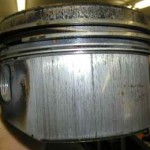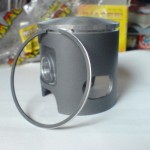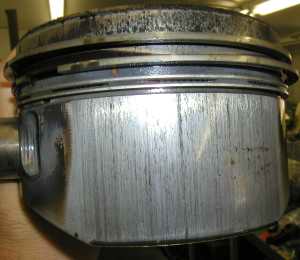
Introduction
It is a very widespread misbelief across tuners that two of the easiest tuning improvements are cutting off the piston skirt and removing the lower piston ring. Most belive that these actions lead to decreased friction which improves cooling and therefore increases the power of an engine. However in most cases these modifications will lead to a piston seizure without any noticeable increase in power.
Why do some pistons have one ring whereas others have two
Especially on high end racing cylinders you’ll find pistons with only one piston ring. Let’s dig into the advantages of a single piston ring first:
- A single piston ring allows for a higher RPM due to reduced friction
- A single piston ring improves cooling due to lower friction
- A single piston ring reduces the likeliness of piston ring issues
However, as always there are also disadvantages when using a single piston ring:
- A single piston ring reduces the compression
- A single piston ring makes the piston unstable
Two important assumptions can be made now when removing the second ring from a two ring piston:
- The piston will last shorter and also stress the cylinder more due to its instability
- The loss of compression needs to be equalized elsewhere

The first assumption explains why we only find single piston ring pistons in aluminum cylinders. Aluminum cylinders have a Nikasil coated surface that makes them more resistant than cast iron cylinders allowing for a higher rpm and more unstable pistons.
The second assumption tells us that we need to take some material off of the cylinder head to achieve at least a similar compression as the engine with two piston rings. Racing cylinder manufacturers have of course taken this into account…
Why do racing pistons have a shorter skirt than original ones
It is not necessarily true that racing pistons always have a shorter skirt. What can be said is that racing pistons never have a piston skirt that is longer than necessary. The secret lies in the question what is necessary. Obviously for an original or eco sport cylinder durability is much more important than for a pure racing cylinder. However, we run again into our cast iron cylinder issue which means that our original cylinders are just too soft to withstand the increased instability of a shortened piston skirt.
What can be done
Minor adjustments to increase the flow inside of the cylinder / crankshaft (bottom dead centre) can and should be done. These changes should not reduce the maximum length of the piston and you should only reduce the necessary parts. The picture on the left hand side illustrates the idea.

Conclusion
Even though racing cylinders proof that it is possible to ride one piston ring and a shorter skirt this is not necessarily true for your cylinder kit. Both changes reduce the durability of the cylinder kit and destabilise the piston. Additionally removing a piston ring also reduces the compression and this loss of compression needs to be equalised somewhere else.
Due to the increased parts wear only Nikasil coated aluminum cylinders can be used when these changes are applied. Parts of the piston skirt however can be removed, when they disrupt the flow in piston bottom dead centre.
Addendum
In his book 2-stroke performance tuning (worth reading for £12.27) Bell describes a usecase where the piston skirt can be removed to increase cooling and air flow. This however does not apply for reed valve scooter engines nowadays anymore.


hello daniel,
i love your site as i just stumbled across it a few minutes ago and was able to browse through the sections. great work, all of you.
but in regards to this article, i have some points regarding pistons that i’d like to clarify. you say that a single ring piston allows for higher rpm due to reduced friction. what kind of friction? if it is the 2nd ring that is the cause of the friction, then i have to disagree. if we look at a piston moving up and down at say 11,000 rpm, it is moving up and down a little more than 183 times per second. if the piston is truly subjected to the kind of rpm loss due to friction, then the ring should not last more than a few seconds. the oil on the cylinder wall and piston/rings prevent this kind of friction from happening or we’d be changing pistons and rings on a daily basis. i would liken it to sliding your bare hand on a dry cafeteria table. let’s say the stroke is 50mm. that means the piston is traveling 100mm per revolution, times 183 (revolutions per second), equals 18,300mm per second. converting that to standard measurements, that’s 720.4 inches per second. multiply that by 3,600 (seconds per hour) and we have 2,593,700.78 inches per hour divided by 12 (inches per foot) = 216141.73 divided by 5280 (feet per mile) and we have a speed of 40.9 mph. now i’m sure you’ll agree that running our dry hand on that table (let’s say it’s really long so it’s a continuous rub like a piston going up and down a cylinder) at 40.9 mph would get really hot and wear our skin down quickly. but if we added a bunch of oil on the table, it would now be possible for us to run our hand on the table with minimal friction and skin loss. depending on the type of oil used, we probably could press down pretty hard and still be able to run our hand on it without much friction. much more pressure than what the rings pressing out on the cylinder walls would make. i’ve thought about it a bit and think that the rpm loss could be from a 2 ring setup may be from the weight of the piston and rings itself. even though the ring is thin and seemingly light, at those reciprocating speeds (dead stop at tdc accelerating to another dead stop at bdc and back again), the rings will have a lot of g-force on them which makes them weigh more than they did not moving. i calculated the inertial force of a 52.5mm piston weighing (w/2 rings) 139.04 grams with a stroke of 50mm (1.9685″) and a rod length of 90.5mm (3.562985″) turning at 11,000 rpm and got these figures:
inertia force is 35.95 pounds
upward inertia force at tdc is 45.88 pounds
downward inertia force at bdc is 26.02 pounds
so the piston and rings that when static weighed just 139.04 grams now weighs 45.88 pounds @ 11,000 rpm’s. just to see how much the rings would weigh, i did the same calculation using first 1 ring, then 2, which is just the weight doubled.
these are the results:
1 ring weighing 2.41 grams =
inertia force is 17.97 pounds
upward inertia force at tdc is 22.94 pounds
downward inertia force at bdc is 13.01 pounds
2 rings weighing a total of 4.82 grams =
inertia force is 35.95 pounds
upward inertia force at tdc is 45.88 pounds
downward inertia force at bdc is 26.02 pounds
so, 2 thin light rings at 11,000 rpm now have an inertial force weight of 35.95 pounds. i’d think that taking 1 ring off would make a substantial difference in rpm’s or rate of rpm’s.
as i’ve already taken up much too much of your page with this, i’ll end here. but please email me and let me know your thoughts on my theory on whether i may be on the right track, or i’m way off.
thank you and best regards,
unkledave
Very good comment, Dave. However, your math is incorrect on upward and downward inertia forces.
hello again daniel,
i have some thoughts on the single ring’s qualities and have to again address some of the facts posted regarding single rings.
how does a single ring improve cooling due to lower friction, as friction is not really a factor given the cylinder wall, piston, and rings are well lubricated as i tried to explain in the reply above. i thought that because combustion heat is transferred directly to the piston dome, then works its way down to the rings, wrist pin, bearing, and conrod, that 2 rings may cool it better as they also hold heat that is transferred to them, and when they reach the lower part of the cylinder where the transfers keep the walls somewhat cooler, are able to do a heat exchange thing as heat always goes to a cold surface and not the other way around.
i also wonder that a single ring piston reduces the likeliness of piston ring issues for the simple fact that instead of sharing compression forces with a second ring, it is all being handled by just the single ring, which is often thinner than the top ring of a 2 ring piston, and if a piston is indeed more stable with 2 rings, then a single ring would be subjected to more forces that would stress it and wear it down even faster i’d think.
as far as a single ring reducing compression, the only way it will lose compression is if compression leaks by it because the ring’s outward tension to push it against the cylinder wall is not strong enough, or it can lose compression through the ring end gap. but if there is that much compression loss through the ring end gap, the hot gasses being channeled through such a small opening is like a blowtorch which focuses the very hot combustion gases onto the cylinder wall and there is a chance it will burn off the protective film of oil there.
i also have a question about the piston being unstable with just a single ring. i had thoughts on this as for the rings to actually be a factor in the piston being stable, the rings would have to have so tight a clearance above and below it to kind of hold it more steady, and because the top of the piston is slightly smaller in diameter than the bottom skirt, to steady the piston via the rings would require that the inside surface of the ring be touching the piston ring groove. wouldn’t it? i’m trying to picture it in my mind and it seems so. i think a lot of piston instability lies in the piston window. unless they add weight to the back skirt to compensate the weight loss from the window the piston is not equally balance in the center. i also think this instability would be more on the upstroke rather than the down stroke as combustion pressure is being equally exerted on the piston’s top. but on the upstroke, the crankshaft is pushing the conrod/wrist pin bearing/wrist pin up toward the piston and the heavier exhaust side would tend resist this force due to more weight than the lighter side.
i’ve heard that some piston manufacturers will offset the wrist pin closer to the front (exhaust) side of the piston to compensate for the metal loss from the window, but that would just balance out the forces only on the upstroke, but then it would translate into an uneven power stroke (down stroke) as the forces of combustion are once again even all over the piston’s top, but because the pin is offset, more pressure will be felt on the back side of the piston as the wrist pin acts as a fulcrum which is not in the center anymore.
so i feel that the only true way to solve this problem is to make the skirt on the rear thicker so that with the wrist pin in the center of the piston, equal forces will be applied on both the down stroke, and the up stroke. all this just came to me as i read your article so i have no factual proof other than what’s turning in my head. i think it would make interesting conversation though and other readers may have the answers and some very good input that i can learn from.
thanks again and best regards,
unkledave
hello again daniel,
i just had another thought regarding the removal of some of the piston skirt on the exhaust side (shortening the skirt overall). i would not recommend it as how the piston and cylinder kits are made, when the piston is at tdc, the bottom of the exhaust skirt covers the exhaust port with just a little bit of the skirt past it for good measure. if this part of the skirt is shortened just a little too much, when at tdc, the bottom of the exhaust port will be open and there is a high chance that a reflecting wave of hot gasses can either ignite the fresh charge that was just drawn in by the upstroke, or at the least it could send in already combusted gases which will contaminate the fresh charge, and just as bad, heat it up. as we know, air rapidly heats up when compressed and compressing hot air is never a good thing in an engine which is why turbocharged air is best when cooled by an intercooler.
thanks again and best regards,
unkledave
I chopped half of the piston skirt on my peugeot 103 sp, plus filed out the exhaust ports and had a very very noticeable increase in performance. I did it to reduce the weight of the piston and improve exhaust flow, it had nothing to do with friction (I left both piston rings on). With less of the piston to distribute the heat, it did run a little hotter, but it ran on that mod for over a year and never seized… moped got stolen.
p.s. thanks unkledave for doing the math!
Hi,
I have a single cylinder 26cc (originally single ringed 34mm piston) gas engine on my helicopter. Cylinder wall is aluminum.I run it at 13.500 RPM. Lately I damaged the cylinder wall as well the piston due to overheat. There are small scratches on the wall. Now It makes less power and bogs on most maneuvers. I already ordered a new top-end but before I install it I want to try a double ring piston to gain the power which is lost due to the damage. I would think the second ring will bring the compression back but since the piston is heavier than the stock one the RPM will drop a bit. I’ll see.
Hi Suat,
Sounds good! Let us know about the results!
Will do Daniel.
Best
Suat
Hi Daniel i have a one question..
I have mhr team cylinder i used only for race .. but now i have stage6 sport pro 70cc its for city riding.. but i change the piston, and the problem’s that the piston is different .. http://media.snimka.bg/s1/3690/033624912-big.jpg?r=0 this size is larger of 3-4 mm .. :X my question is that if i take spacer for cylinder to up the cylinder! Are i have a other problems ? thanks :)
Hey,
Yes, you can’t do this :) You will loose all your compression if you raise the cylinder head. There are two types of spark plugs. Long ones and short ones. Short ones are usually used in air cooled engines, where long ones are used for liquid cooled ones!
hi im new to this, i just put tohether a 70cc for a regular bike, well the transfer ports are on the cylinder and they got big, big to the point that its not a hole anymore, its just all open, now, the engine will run for a good 3 blocks then bogg out, can this be fixed without buying anything?
many racing engines in the 50cc class use L-rings on top of the piston, and no other rings. The L-shape makes them seal enough so no compression loss. Skirts just long enough for stability.
Can anyone definitively say whether the outside bevel/chamfer on two stroke piston rings faces up or down?